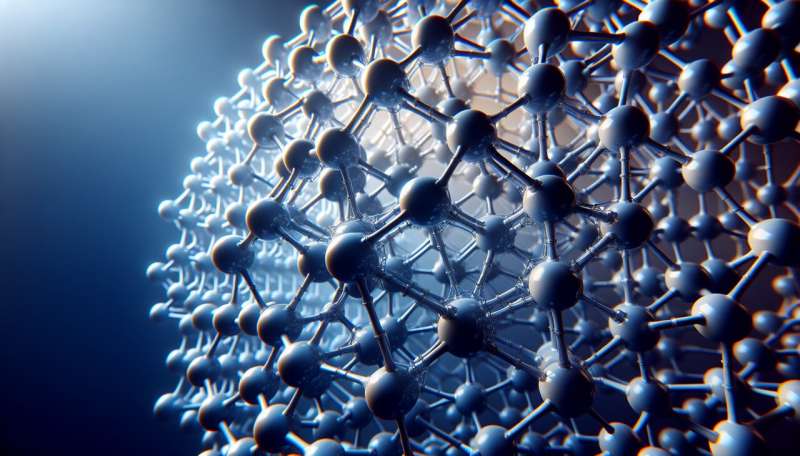Quantum spin liquids (QSLs) are fascinating and mysterious states of matter that have intrigued scientists for decades. First proposed by Nobel laureate Philip Anderson in the 1970s, these materials break the conventional rules of magnetism by never settling into a stable magnetic state, even at temperatures close to absolute zero.
Instead, the spins of the atoms within them remain constantly fluctuating and entangled, creating a kind of magnetic “liquid.” This unusual behavior is driven by a phenomenon called magnetic frustration, where competing forces prevent the system from reaching a single, ordered configuration.
QSLs are notoriously difficult to study. Unlike ordinary magnetic materials, they don’t show the usual signs of magnetic transitions, which makes it hard to detect and understand them using traditional techniques. As a result, their behavior has remained an elusive puzzle for researchers.
The material β’-EtMe3Sb[Pd(dmit)2]2, a molecular crystal featuring a triangular lattice, has been a strong candidate for exhibiting QSL behavior. The way these spins are arranged creates inherent frustration because the interactions between neighboring spins cannot all be satisfied at once.
This setup seems ideal for a QSL state, but while earlier studies suggested that it might behave like a quantum spin liquid, scientists were not sure whether it was truly a 2D QSL, or if other factors, like a reduction in dimensions, were influencing its behavior. This question has been at the heart of current research.
A study involving Professor Yasuyuki Ishii from Shibaura Institute of Technology, Yugo Oshima and Hitoshi Seo from the RIKEN Cluster for Pioneering Research, Francis L. Pratt from the Rutherford Appleton Laboratory, and Takao Tsumuraya from Kumamoto University, published in the journal Physical Review Letters on December 3, 2024, provides interesting insights into this mystery.
Professor Ishii and Dr. Oshima had independently observed signs of one-dimensional spin behavior of β’-EtMe3Sb[Pd(dmit)2]2 in muon spin rotation (µSR) and electron spin resonance (ESR) experiments, respectively, but these were far from the conventional idea of 2D triangular magnets, so they were at a difficult time in interpreting them.
They then asked for a theoretical analysis from Dr. Seo, Associate Professor Tsumuraya, and their colleagues. Finally, using advanced theoretical modeling, the researchers discovered that spin dynamics in this material are dominated by quasi-one-dimensional (1D) behavior, challenging traditional expectations of 2D QSLs.
The authors, specialists in magnetic resonance and novel magnetic phenomena, combined ESR and μSR with theoretical modeling to explore β’-EtMe3Sb[Pd(dmit)2]2. “We present a different experimental approach for studying the ground state of β’-EtMe3Sb[Pd(dmit)2]2 using ESR and µSR
ESR measures spin anisotropy and diffusion by analyzing the magnetic response of electrons in the material. μSR provides insights into the material’s spin relaxation dynamics and dimensionality by tracking how muon spins interact with magnetic fields.
These experimental techniques were complemented by density-functional theory (DFT) calculations and extended Hubbard model simulations to understand the electronic structure and magnetic interactions.
They found that the spin behavior in β’-EtMe3Sb[Pd(dmit)2]2 is dominated by quasi-1D (one-dimensional) dynamics, rather than the expected 2D behavior. Although 1D spin diffusion should normally appear in the direction where the magnetic interaction is strongest, the direction indicated by ESR has been considered the weakest interaction in the triangular lattice based on previous theoretical calculations.
This was surprising because the material’s 2D structure led scientists to expect 2D spin dynamics. Muon spin relaxation experiments confirmed a B-0.5 pattern in spin relaxation, which is a signature of 1D spin diffusion. ESR also supported this, showing that spin movement was anisotropic or direction-dependent.
“The unique properties of quantum spin liquids have the potential for future applications in next-generation technologies such as quantum computers and spintronics devices. The present research is an important step toward this foundation and will open the way for future technological innovations,” adds co-author Yugo Oshima, describing the contributions of the study.
Despite these new insights, there are still questions about how exactly dimensional reduction works in this context. The relationship between magnetic frustration, quantum fluctuations, and multi-orbital effects needs further investigation.
Prof. Ishii and the team plan to apply their methods to study other QSL candidates, aiming to uncover general rules that govern these materials. Their work emphasizes the importance of using advanced techniques like ESR and μSR to tackle the challenges of studying QSLs.
By confirming that quantum spin-liquid states exist and can be measured dynamically, this study brings researchers closer to unlocking the full potential of these strange materials.
More information:
Yugo Oshima et al, Quasi-One-Dimensional Spin Dynamics in a Molecular Spin Liquid System, Physical Review Letters (2024). DOI: 10.1103/PhysRevLett.133.236702. On arXiv: DOI: 10.48550/arxiv.2410.20076
Provided by
Shibaura Institute of Technology
Citation:
Researchers uncover 1D-like spin behavior in a triangular molecular lattice, challenging traditional views (2025, February 5)
retrieved 5 February 2025
from https://phys.org/news/2025-02-uncover-1d-behavior-triangular-molecular.html
This document is subject to copyright. Apart from any fair dealing for the purpose of private study or research, no
part may be reproduced without the written permission. The content is provided for information purposes only.

